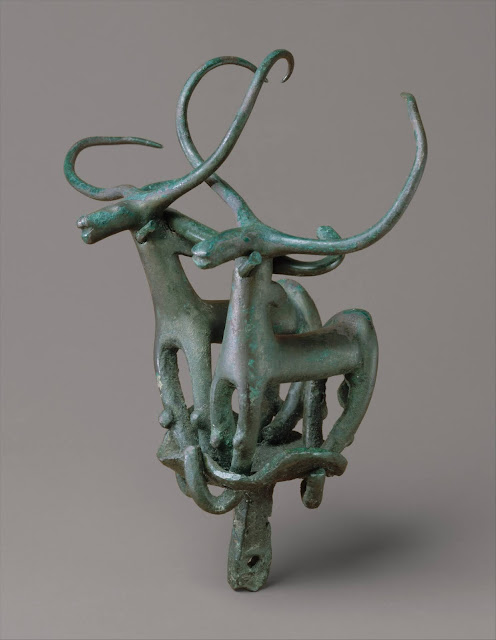The Storm God of the Hatti then Hittite
During the early Bronze Age the Hatti, who were neither Semitic nor Indo-European, inhabited central Anatolia. They were actually distinct from the Hittite but as the Hittite expanded beginning about 2000 BCE, the Hatti were gradually absorbed into the Hittite political and social order.
The Hatti were organized in monarchical city-states. These states were ruled as theocratic kingdoms or principalities. Hatti regions of Anatolia came to be influenced by mighty Mesopotamian polities, in the form the Akkadian Empire (24th-22nd century BCE) and the succeeding Old Assyrian Empire (21st-18th century BCE), both of which set up trading colonies called karum, located throughout eastern and central Anatolia. During the first centuries of the 2nd millennium BCE, an Assyrian trade colony existed in the city of Hattush, and several Assyrian inscriptions mention the existence of local rulers (kings) of Hattush, also referring to their relations with other city-states in the region.
Fortunately, a few fragments of text in the language of the Hatti were discovered among the Hittite archives. Their language is now believed by some scholars to be related to the Northwest Caucasian language group.
The Hatti worshiped a mother goddess Kattahha (or Hannahanna) who gave birth to the storm-god Taru represented by a bull. The Hittites subsequently adopted much of the Hatti pantheon. Taru was adopted as Tarhunt and referred to as 'The Conqueror', 'The king of Kummiya', 'King of Heaven', and 'Lord of the land of Hatti.' His image was paraded through the streets at the festivals of Puruli in the spring, the Nuntarriyashas festival in the autumn, and the Ki Lam festival of the gate house.
The Puruli festival celebrates the battle between the dragon Illuyanka and the Storm God. Initially the Storm God is defeated by the serpent. The Storm God then goes to the Hatti goddess Inaras for advice. Having promised to sleep with a mortal named Hupasiyas in return for his help, she devises a trap for the dragon. She goes to him with large quantities of food and drink and entices him to drink his fill. Once drunk, the dragon is bound by Hupasiyas with a rope. Then the Storm God appears with the other gods and kills the dragon.
In an alternative version of the myth, the dragon takes the Storm God's eyes and heart when he initially vanquishes the Storm God. To avenge himself upon the dragon, the Storm God marries the daughter of a poor man. They have a son, who grows up and marries the daughter of the dragon Illuyanka. The Storm God tells his son to ask for the return of the Storm God's eyes and heart as a wedding gift and he does so. His eyes and heart restored, the Storm God goes to face the dragon Illuyanka once more. At the point of vanquishing the dragon, the Storm God's son finds out about the battle and realizes that he had been used for this purpose. He demands that his father take his life along with Illuyanka's and so the Storm God is forced to kill them both.
 |
| Standard with two long-horned bulls, 2300-2000 BCE, Hattian, now in the collections of the Metropolitan Museum of Art in New York City, image courtesy of the museum. |
 |
| Vessel terminating in the forepart of a bull, Hittite, 14th-13th century BCE, Silver, now in the collections of the Metropolitan Museum of Art, image courtesy of the Museum and Wikimedia Commons. |
 |
| Silver bull figure from Alacahöyük, 2300 BCE, now in the collections of the British Museum, image courtesy of Wikimedia Commons contributor Ollios. |
 |
| Vase with bull protome, first quarter of 2nd millenium, now in the collections of the Museum of Anatolian Civilizations, courtesy of Wikimedia Commons contributor Homonihilis. |





Comments
Post a Comment